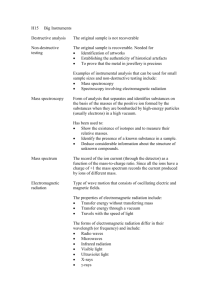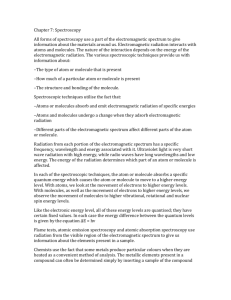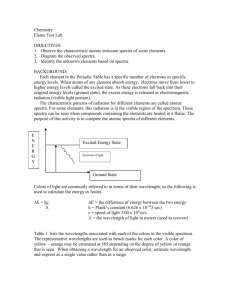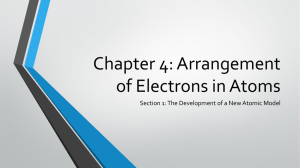Spectroscopy notes
advertisement
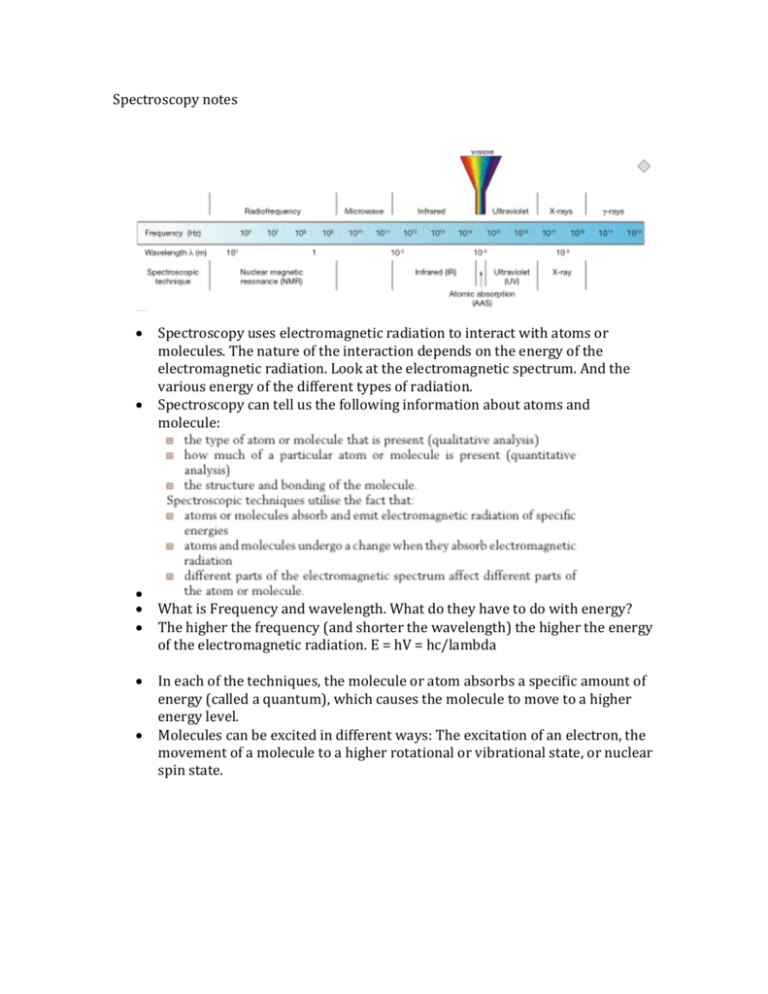
Spectroscopy notes Spectroscopy uses electromagnetic radiation to interact with atoms or molecules. The nature of the interaction depends on the energy of the electromagnetic radiation. Look at the electromagnetic spectrum. And the various energy of the different types of radiation. Spectroscopy can tell us the following information about atoms and molecule: What is Frequency and wavelength. What do they have to do with energy? The higher the frequency (and shorter the wavelength) the higher the energy of the electromagnetic radiation. E = hV = hc/lambda In each of the techniques, the molecule or atom absorbs a specific amount of energy (called a quantum), which causes the molecule to move to a higher energy level. Molecules can be excited in different ways: The excitation of an electron, the movement of a molecule to a higher rotational or vibrational state, or nuclear spin state. copy table Part 1 – Analysis of elements in compounds: Flame tests, AAS, AES Flame tests (for metal ions in compounds) - Salmples are burnt in a nonluminous flame. If the flame changes colour, then the colour is compaed with a set of known colours, to determine the metal ions present. Electrons in energy levels close to the nucleus have the lowest energies and experience the strongest attraction to the nucleus. An electron can jump to a higher energy level if it absorbs energy that corresponds exactly to the difference in energy between the lower energy level and the higher energy level. When electrons jump to a higher energy level they move to a higher energy subshell in a different shell. For some metal atoms, the heat of a Bunsen flame provides sufficient energy for this to happen. Higher energy levels are unstable so the excited electrons quickly return to lower energy levels, emitting the energy they had absorbed. If the energy emitted falls within the band of energies visible to the eye, it can be seen as coloured light (Figure 7.7). Radiation emitted from other parts of the electromagnetic spectrum, such as the ultraviolet region, is detected using instruments. The energy of a photon of light emitted by an excited electron has a fixed value, equal to the difference in energy between the higher energy level and the lower energy level to which it returns. The light consequently has a specific wavelength and colour. Because electrons can be excited into different energy levels, they can can give off different quantum’s of energy (i.e. different amounts of energy, meaning different colours of light) What are the limitations of this analysis? Different elements can emit similar colours of light. The analysis is only qualitative. Atomic Emmision Spectroscopy This is a similar principle to flame tests, but uses: A hotter flame, enabling the electrons in the outer shell to just to all the possible energy levels. A prism is used to split the light emmitesd from the sample, showing us all the bands in the excitation spectrum. Every line on the emmision spectrum corresponds to radiation of a specific frequency, wavelength and energy level equal to the difference in energy of the electron energy levels. We get specific lines because the energy is quantised Limitations – Still only qualitative, and largish sample concentrations needed. Atomic Absorption spectroscopy In this technique, instead of looking at the emissions of electromagnetic radiation, it looks at the absorption of electromagnetic radiation. It can detect over 70 elements (limited, because some elements wont be excited by even the hottest of flames What does it test? Metal Ions.. Each element will absorb light of a specific energy to excite en electron to a specific energy level. In order to generate this exact energy, the light source if made from the element itself. This is called a hollow cathode lamp Very important, a different light source will be needed for each different element to be analysed. The cathode of the lamp is made of the analyte metal, which, when vaporised will emit light of the required wavelength. Steps: 1. The sample is dissolved into water 2. It is then sprayed into the flame, where it is converted into an atomic vapour. 3. Light containing the predetermined wavelength is passed through the flame 4. Atoms of the element being analysed will absorb some of the light (proportional to the concentration of metal ions in solution. 5. The light is passed though a monochromator (which allows selection of light of a specific wavelength. 6. This is then measured using a detector. How do we use this for quantative analysis? Make standard solutions and create a calibration curve! Then plug in the values. Just quickly: List which type of analysis each method is appropriate for, List the pros and cons of each, List the types of information which can be obtained from the analysis, List the sample form and draw a diagram of each technique. A different technique: Uv-visible spectroscopy We know that substances will absorb energy of certain values.. Some of these energy quantum’s happen to be in the visible and UV regions. The particular wavelength of light that a compound will absorb will tell us about its structure, allowing us to identify the compound. Every compound is unique because in each compound the arrangement of electrons, and interactions with the nucleus is different, hence less or more energy in bonds etc.. The wavelengths of UV and Visible spectrums has enough energy to promote electrons to higher energy levels. Beer lambert law A=ecl (Absorbance 0-1 = morlar absorptivity constant x concentration x path length) This technique uses light in the UV- Visible region to

